- This topic has 22 replies, 3 voices, and was last updated 10 years, 11 months ago by
 Bill Ward.
Bill Ward.
-
AuthorPosts
-
4 January 2015 at 7:45 pm #573405
 Bill WardParticipant
Bill WardParticipantHi,
The weather held, more or less, here. Right on the peak as indicated by radio counts (~02-03UT this morning the 4th) the clouds did roll in. Anyway had the system on and caught a good haul on video as well as 14 spectra. Four of these were Quadrantids. A few technical problems still need to be resolved but here’s a low res spectrum and the usual colour treatment.
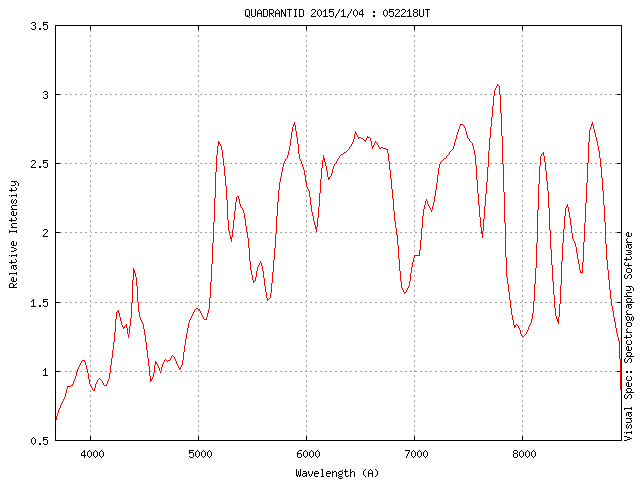

cheers,
Bill.
5 January 2015 at 9:54 am #576737 Alex PrattParticipant
Alex PrattParticipantHi Bill,
I really like your composite diagrams, showing the spread of colours along the range of wavelengths and the plot of their intensity levels. An excellent way to illustrate a meteor spectrum.
I had clear skies on Jan 3/4 and in spite of the almost Full Moon my Leeds_NW and Leeds_SE cameras recorded a total of 192 meteors, of which 103 were Quadrantids, with a mean mag of around 1.5.
I’m hopeful that we’ll obtain some multi-station data when you can operate a south-facing camera during Moonless nights.
Clear skies,
Alex.
6 January 2015 at 9:06 am #576738 Bill WardParticipant
Bill WardParticipantHi,
Thanks Alex, That’s the plan. I have one on bearing 130 at ~45 deg as weather permits.
Back to the Quadrantids, I did record several others, all fainter and one through considerable cloud. When processing them I noticed something of (possible) significance.
Consider:




These are the synthetic spectra of 4 Quadrantids.
Q1 is of the first post. Q2, Q3 and Q4 were the fainter ones.
Note: I have made no attepmt to align the lines in this case. They were all captured with the same 300 groove/mm grating. Due to varying angles with respect to the dispersion axis it looks like they have different dispersions (the lines at varying distances from one another) this is a geometric effect caused by the re-orientation process. The physical dispersion is the same in all.
Now, it is apparent that Q2, Q3 and Q4 have the green Magnesium (~518nm) line brighter than the yellow Sodium (~590nm) line. With Q1 it is a bit difficult to tell. This is where the graphs now have to come into play.
So,
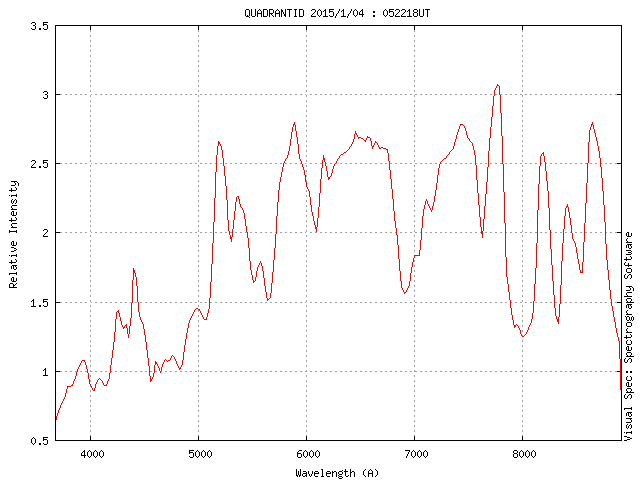
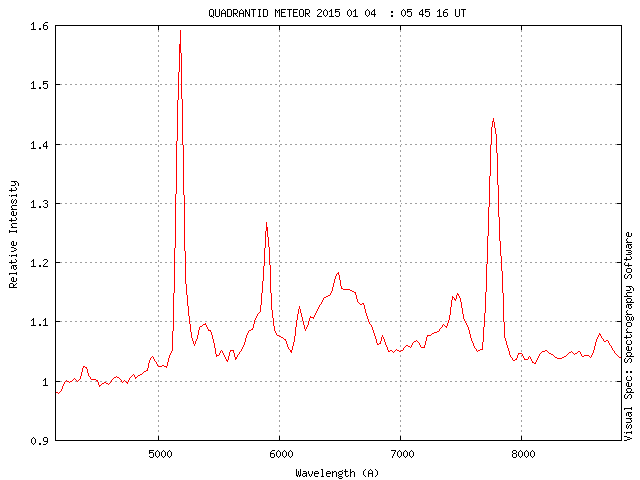
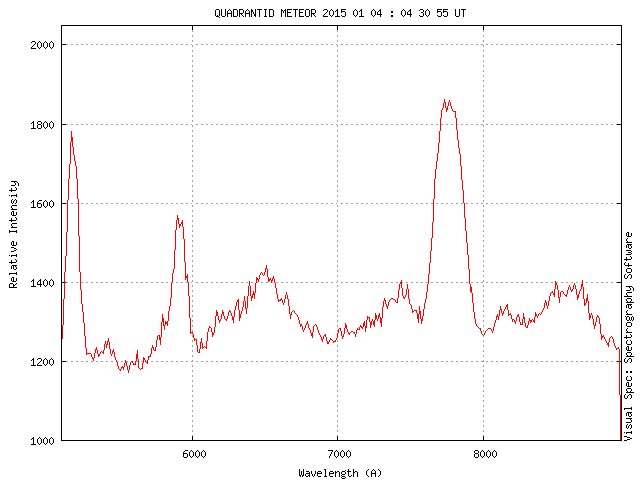
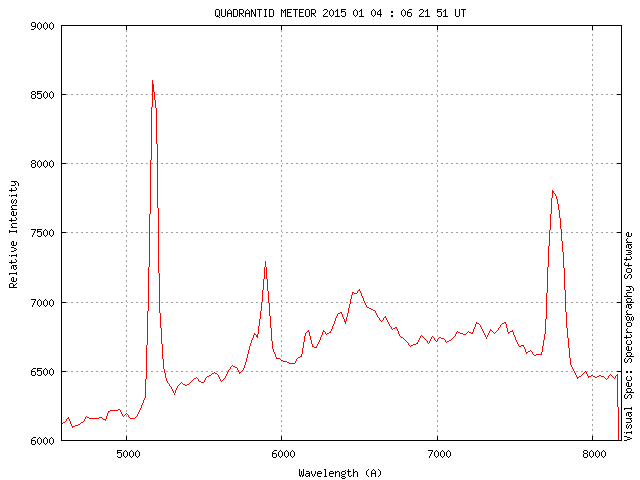
The graphs are in the same order. It is clear that Q1 is the only one where the Magnesium line (518nm) is lower than the Sodium line (590nm).
(Worthy of a “Ta Dah!” at this point, perhaps)
So does this mean that Q1 was not a Quadrantid, I’m not sure. (I don’t think anyone would be either) A, presumably, slightly larger meteoroid would experience different heating and stress which could conceivably result in a different emission profile.
However, it could be that Q1 was not a Quadrantid afterall and merely was coincidental on the sky with respect to the radiant.
A Quadran Muralis mystery….cheers,
Bill.
6 January 2015 at 10:41 am #576739 Alex PrattParticipant
Alex PrattParticipantHi Bill,
Fascinating stuff.
You also have additional camera alignment options with David Anderson and Denis Buczynski.
I recorded 103 Quadrantids on Jan 3/4, but in addition there were 18 meteors that UFO Analyser categorised as J5_daD (December alpha Draconids). This shower has been confirmed by SonotaCo data, but its radiant lies close to that of the Quadrantids, being active at a similar time of year and with similar Vg.I always regard shower membership from single-station work as provisional. A single-station meteor could be assigned J5_daD membership, then later identified as a Quadrantid from dual- or multi-station analysis.Is it possible that you have a mixture of Quadrantid and December alpha Draconid spectra?Cheers,Alex.6 January 2015 at 12:44 pm #576740 Bill WardParticipant
Bill WardParticipantHi,
I find it remarkable that we can do disect the meteor so thoroughly!
My opening sentence should have been “…as weather AND moonlight permits.” It is a significant problem, the gratings are designed to diffract light afterall. It’s just they do is so well in some un-desired circumstances 😉
Mmm, the daD shower is an interesting option, just goes to show the possibilities.
Yes, I had the same idea regarding the Vg. Is this included in the log files that Capture generates for passing to Orbit? Or is it dervied from multiple stations in Orbit? I am clearly out of touch with the subtleties of multi station work. I’ll check the file tonight as that would clinch it. Do you have any Vg values for the daD?
Utterly fascinating.
Cheers,
Bill.
6 January 2015 at 1:33 pm #576741 Alex PrattParticipant
Alex PrattParticipantHi Bill,
As discussed offline, the meteor shower data are suppiled in the ULE_J5.csv and ULE_J6.csv files bundled with the UFO software suite.
They are also listed in the IAU MDC
The Vg of the two showers are essentially the same, 41.36km/s (Quads) and 41.6 (DaDs).
UFO Analyser derives an estimate of the meteor’s velocity from a single-station recording, then UFO Orbit computes an estimate of its geocentric velocity using data from two or more stations.
Cheers,
Alex.
6 January 2015 at 3:34 pm #576742 Alex PrattParticipant
Alex PrattParticipantHi Bill,
Here’s a plot of both radiants, from UFO Orbit.
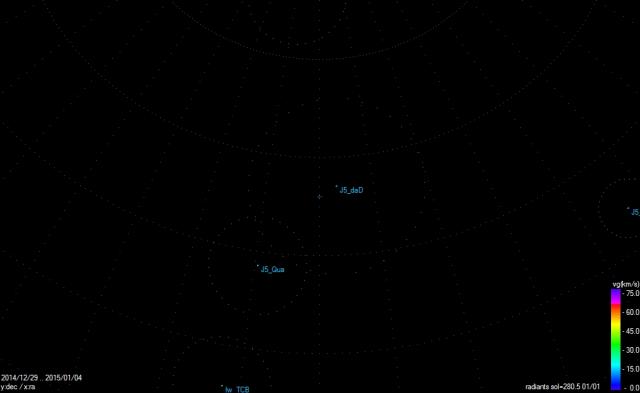
If the December alpha Draconids are accepted as a genuine minor shower we can have cases where some of their meteors are mis-identified as Quadrantids, and vice versa.
Clear skies,
Alex.
6 January 2015 at 9:02 pm #576745 Bill WardParticipant
Bill WardParticipantHi Alex,
The radiants are quite close. I’ve had another look at the various videos. I’ve only got the tail of Q1 in the wide field. But I caught it on two of the spectro systems. (a 300 g/mm and a 600g/mm) I’m tempted to say it “looks” a touch faster than the others.
Q1 looks very like the fireball spectrum in the other thread. In Q2, Q3 and Q4 the only really prominent atmospheric line is at 777.4nm, the others from O and N are very weak unlike Q1. Since these are taken to be atmospheric this might suggest a less “energetic” entry as, that is perhaps a lower velocity for the 3.
Maybe its a case of just actually believing what we see. Q1 looks significantly different to Q2, Q3 and Q4 so it probably is. Whether it is indeed a sporadic imposter or a daD, that’s another question!
Oh well if it’s not a Quadrantid, and maybe not even a daD then my tweets were all nonsense (but nothing new there then)
It better be clear next year so I can check!
Cheers,
Bill.
7 January 2015 at 3:02 pm #576749 Bill WardParticipant
Bill WardParticipantHi,
Just another thought. Have we ever been in this situation before? By that I mean has there been any other time when so much detailed data has been available for consideration these sorts of questions can even be asked? Rather than just a numbers game we can now get right down to the orbits and composition of the meteorids.
Bodes well for meteor astronomy I think!
Cheers,
Bill.
7 January 2015 at 4:03 pm #576750 Bill WardParticipant
Bill WardParticipantIn an effort to try and find out more about Quadrantid spectra I did a “google”. One paper appeared a few times. Titled “First Results of Quadrantid Meteor Spectrum” by Shinsuke Abe et al. The paper is here: Lunar and Planetary Science XXXVI (2005), PDF 1536.
The text says they analyzed 4 sets of data (mmm there’s another coincidence…). What is truly spooky is the image shown on the summary page is this (which I cut from the document)
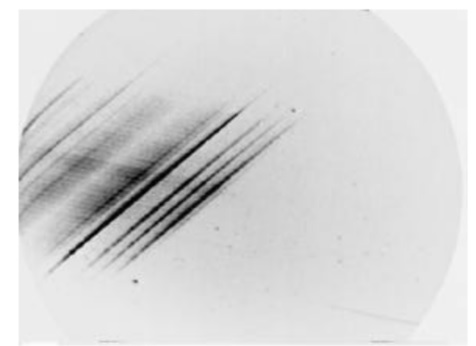
Now I have re-aligned and inverted the grey scale on my own image so that an easier comparison can be made, thus:
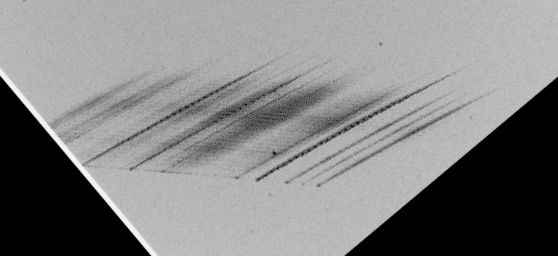
They are almost identical!
I will need to re-process Q1 in case there is some binning issue or other geometrical effect I’m missed. If the magnesium lines still comes out weaker than the sodium line then that’s a cosmic cat amongst the celestial pidgeons. If it corrects then bigger meteoroids produce more intense emissions. (Perhaps that’s even common sense.) The differences in spectra may then be a function of the way a given mass ablates.
Proper science guv!
cheers,
Bill.
7 January 2015 at 4:39 pm #576751 Bill WardParticipant
Bill WardParticipantWell, well, well…
A rough and ready re-do of a SINGLE frame reveals:
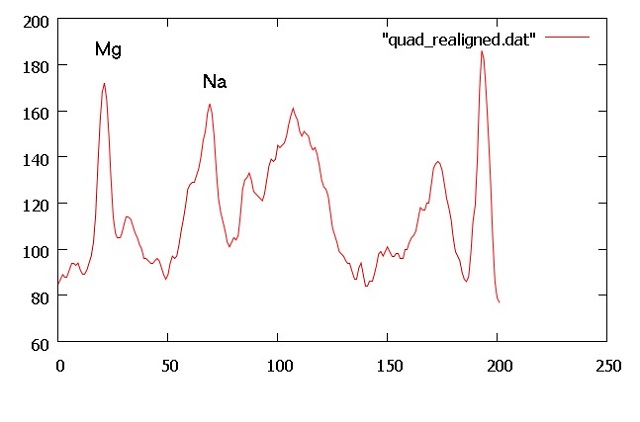
The Magnesium line does indeed squeak up a bit! There’s definitely dodgy dealings going on with the binning but I don’t know if this is enough to swing the issue.
It’s all good fun and I’m off for a cuppa….
7 January 2015 at 8:01 pm #576752 William StewartParticipant
William StewartParticipantHi Bill,
Looks like you’re getting some very interesting results – hopefully by now you have enough for a paper 🙂
Would be be very interested to see how the emission line intensities vary with ablation rate (which could be inferred from altitude / deceleration) … hopefully it won’t be too long before we can get triangulation data on one of your “spectral” meteors.
Clear skies
William
7 January 2015 at 8:45 pm #576753 Bill WardParticipant
Bill WardParticipantHi William,
I genuinely cannot believe what is possible now, even a year ago I never imagined I’d be getting such results. The group in the 2005 paper were using image intensifiers and other bits of technology. Now it’s just straight out of the box!
Alex made the point well, once we finally get some mutual orbital data for a good sample size we’re into new territory.
I’ve had no feedback from the “Lens man” yet but if I get a couple of these fast lenses I’ll have sufficient to kit out all the cameras with a fast lens and decent grating. Computing problems are the next issue to be addressed. Need to have a chat with my IT guru’s.With a couple of teasers last year I’m planning on have two south point cameras this year during the Lyrids. weather permitting. The moons situation is good so that’s the plan.
cheers,
Bill.
9 January 2015 at 12:11 am #576754 Bill WardParticipant
Bill WardParticipanttest
9 January 2015 at 12:23 am #576755 Bill WardParticipant
Bill WardParticipantThis is the composite video of the early part of the meteor (Q1). Does this look like it’s coming from a bit off radiant?
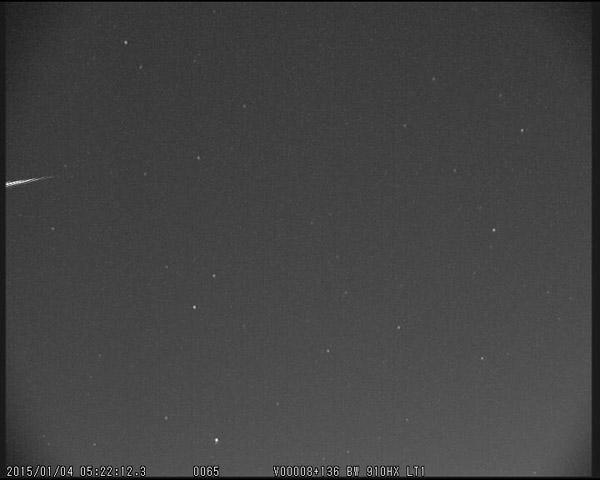
What say ye?
I’ve tried other separate video lines and they mostly have more sodium than magnesium. So the binning can be fooled by the interline gaps on images that are not re-oriented perfectly vertically over the whole spectrum in question.
I’ve seen another image from Japan. It only shows limited lines but if the dispersion is as I think then the magnesium line is much stronger than the sodium line. Just like the other three here. The celestial pidgeons might be getting nervous…
cheers,
Bill.
10 January 2015 at 9:13 am #576759 Alex PrattParticipant
Alex PrattParticipantHi Bill,
UFO Analyser can display the meteor trail against the star field, compute its probability of shower membership (from its internal catalogue) and it will measure its offset from the radiant.
This is more objective than an alignment by eye.
Clear skies,
Alex.
10 January 2015 at 10:41 pm #576761 Bill WardParticipant
Bill WardParticipantYep, The operational problems caused by moonlight preclude permenant orientation so Analyser not useable which is a pain in the neck.
The following spectrum was derived from an image taken by the Japanese observer Koji Maeda.
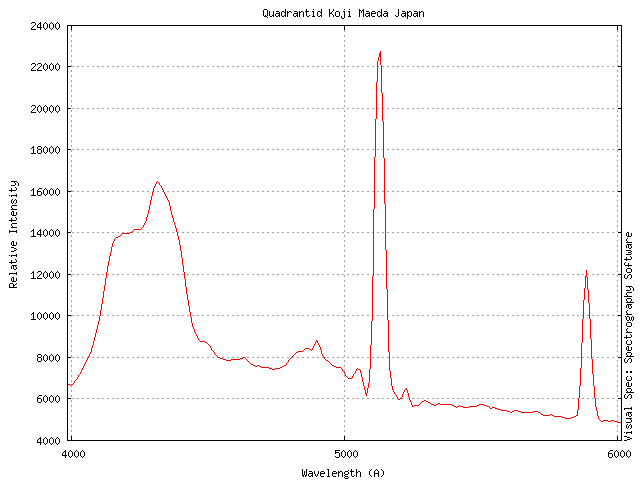

I don’t think there can be any more doubt that these spectra reveal there is a particular composition to some Quadrantids. It’s a whole other ball game to consider what might cause the difference (assuming the first spectrum IS of a Quadrantid).
cheers,
Bill.
11 January 2015 at 9:58 pm #576768 Alex PrattParticipant
Alex PrattParticipantHi Bill,
Yes, UFO_A is normally used to process meteor captures from a wall-mounted video camera, but it can also be used to analyse meteors from a one-off tripod-mounted session.
This would help to assess whether all your spectra are from Quadrantids or if there’s any DaDs in there.
The parent body of the Quadrantids is believed to be 2003 EH1, an Amor NEO. Multi-station observations of the Quadrantids in 2014 by the NEMETODE team showed that the meteors were extinguished at higher altitudes than the Geminids, even though they have similar Vg, suggesting that Quadrantids are more fragile material.
Cheers,
Alex.
11 January 2015 at 11:49 pm #576769 Bill WardParticipant
Bill WardParticipantHi Alex,
I’ve tried it with the mobile rig but the problem I found is it stronly depends on the lens/grating/sky conditions.
I’m not quite sure why there are differences between what are osetensibly the same set ups but some of the gratings seem to be a lot more transparent than others (across the 600 g/mm ones.) and varies the reference stars, if any, that can be seen. That’s the problem. However, I never thought to try the 300g/mm which shows more stars. I caught “Q1” on that too. I’m not sure how it will handle the “width” of the spectrum though. Can you manually indicate start and end points? Then I could select a single line.
It interesting you mention the Geminids. Although I only got one spectrum from that shower despite vastly more meteors, it showed the expected result. That is a sodium deficiency however with the results here I think it can be safely concluded that the quadrantids (or a subset thereof) are sodium deficient too. That might be in the professional literature but I’ve never heard of it. Need to check.
Cheers,
Bill.
13 January 2015 at 7:38 am #576772 William StewartParticipant
William StewartParticipantHi Bill,
In short, yes, gve me a call and I’ll talk you through the process.
Cheers
William
-
AuthorPosts
- You must be logged in to reply to this topic.
